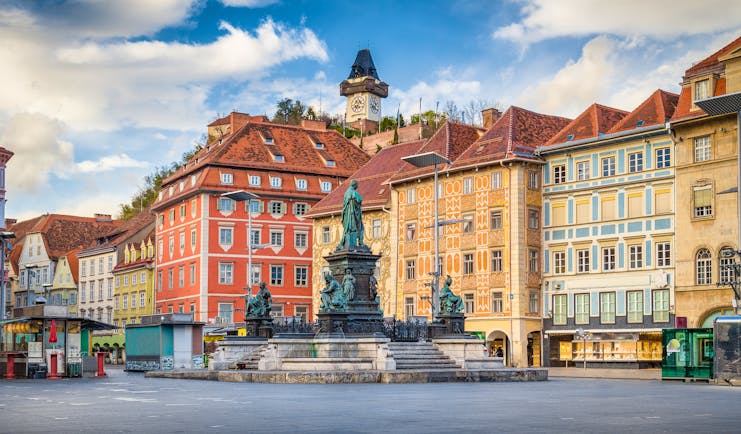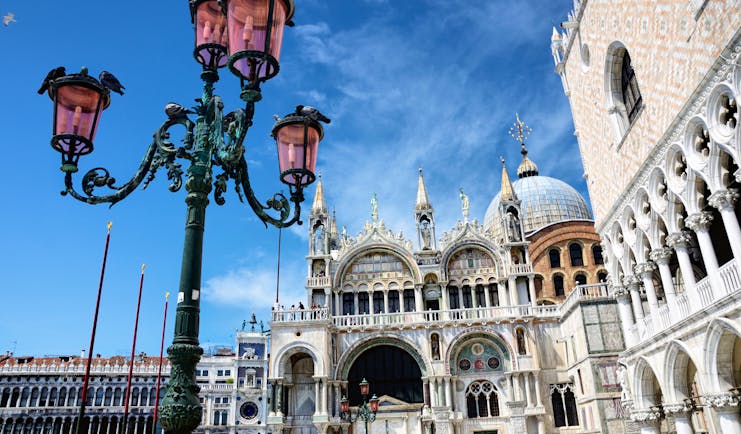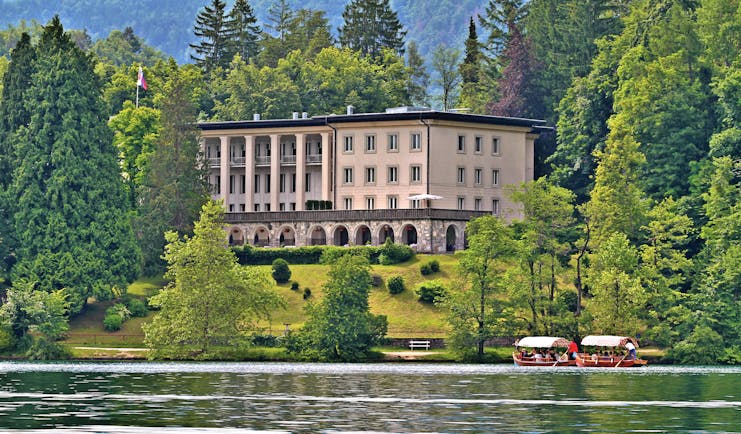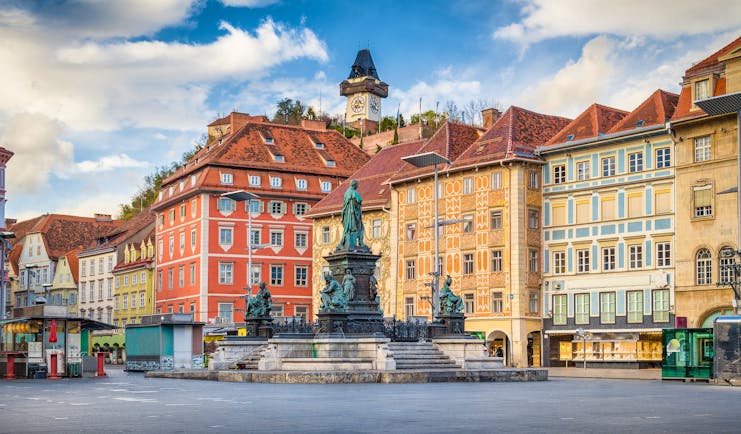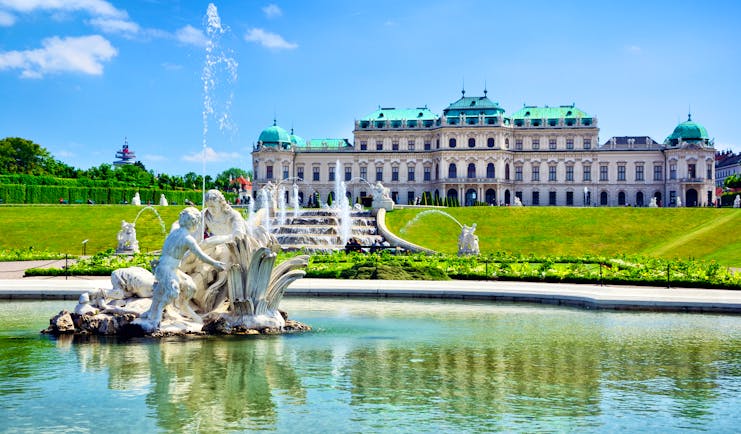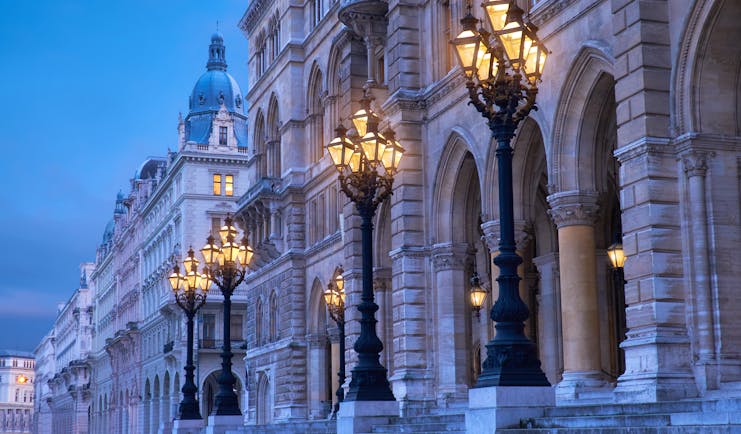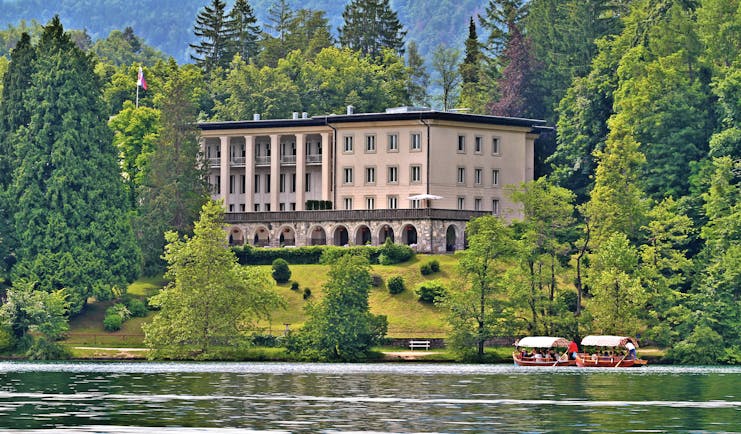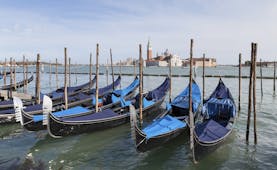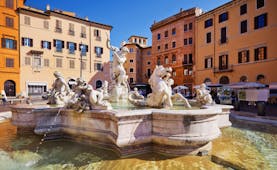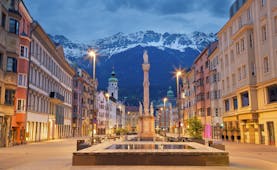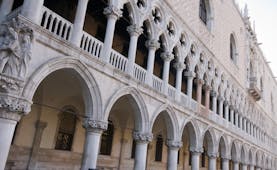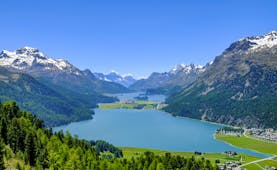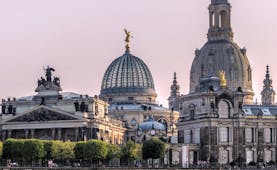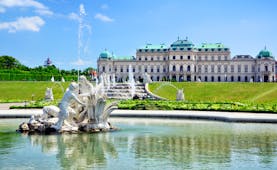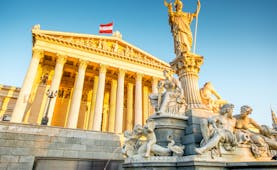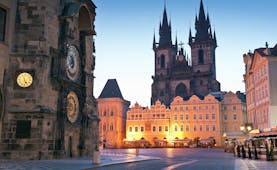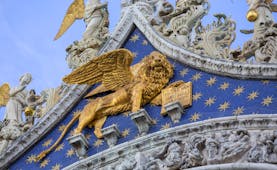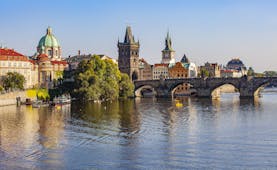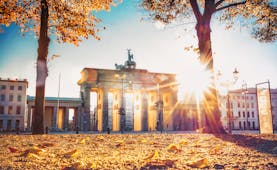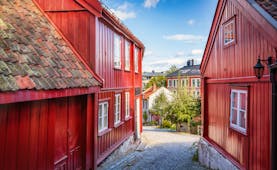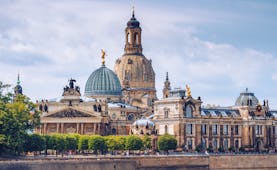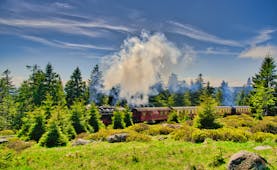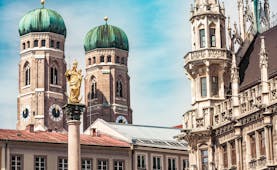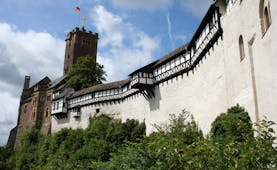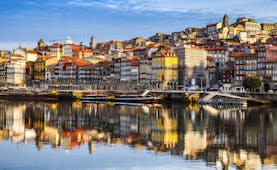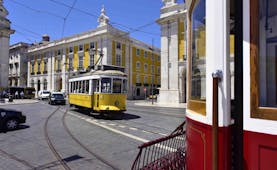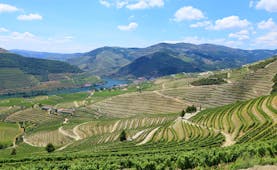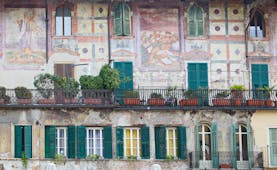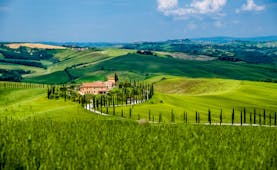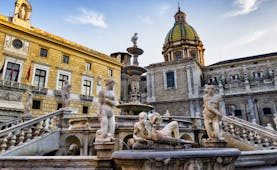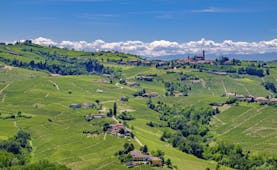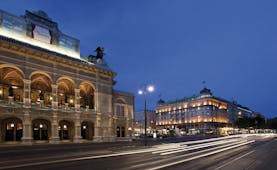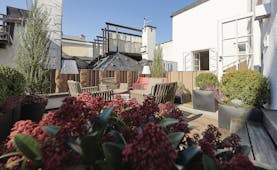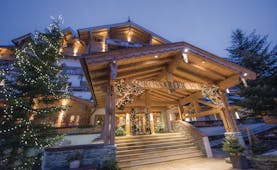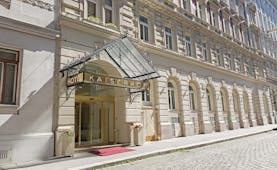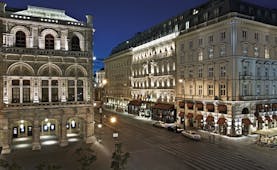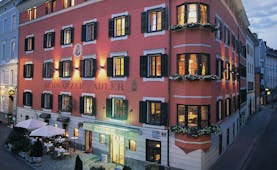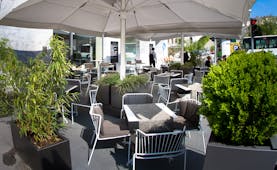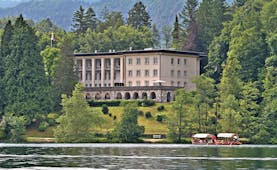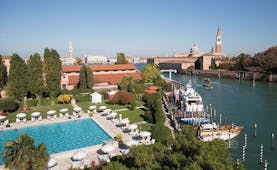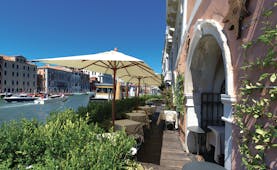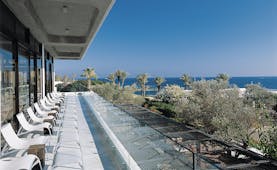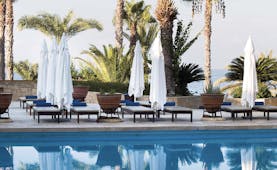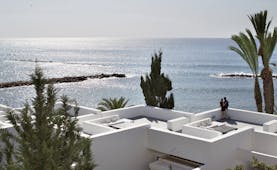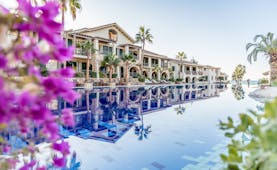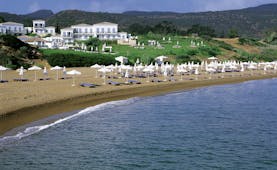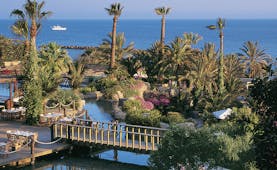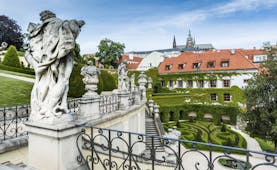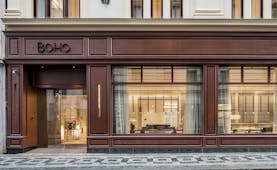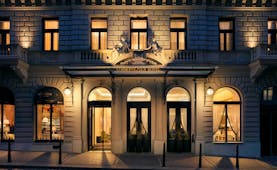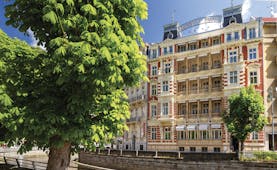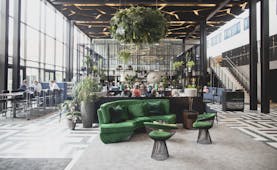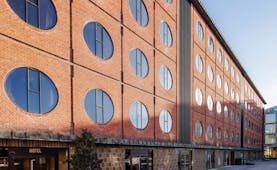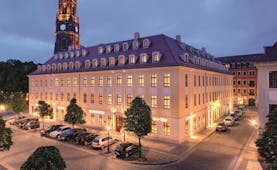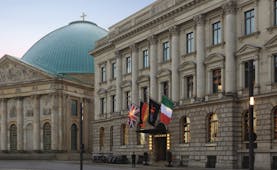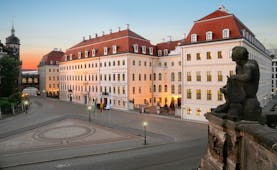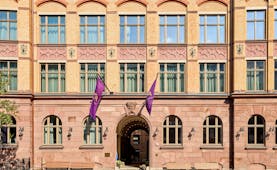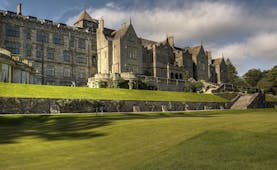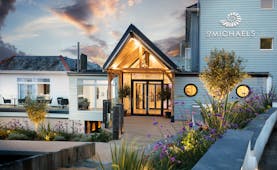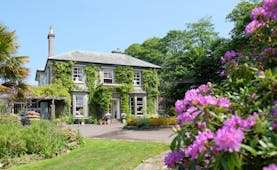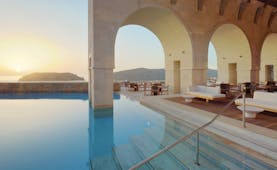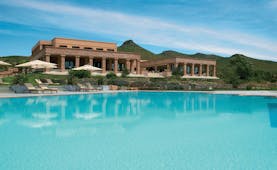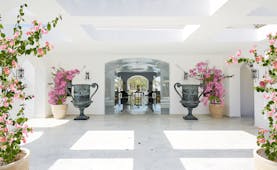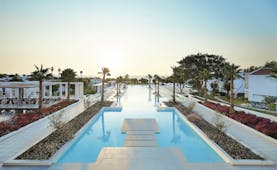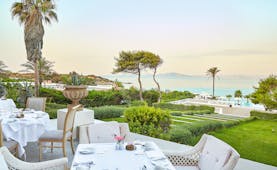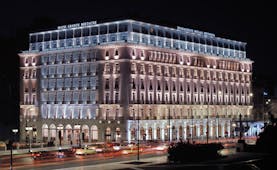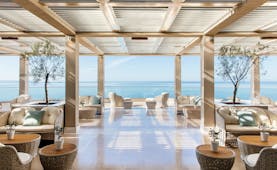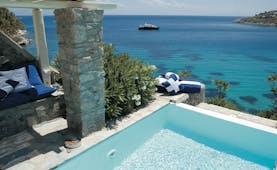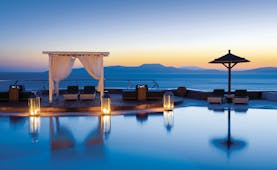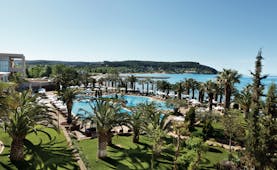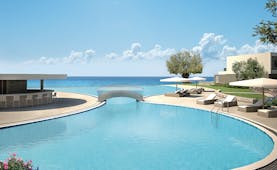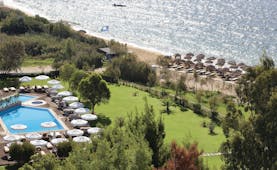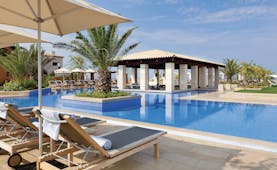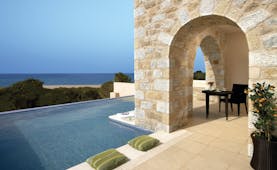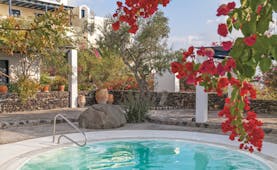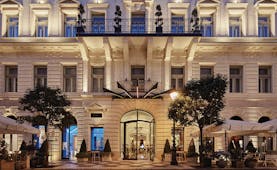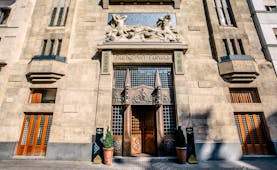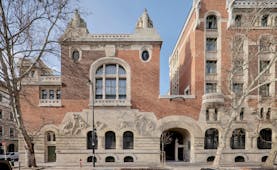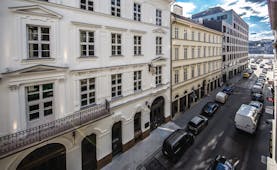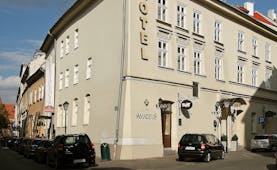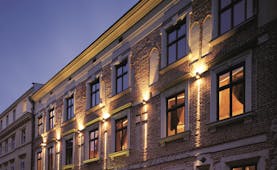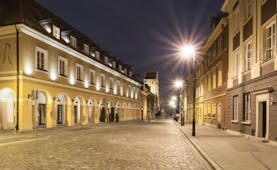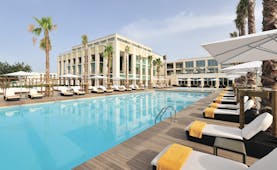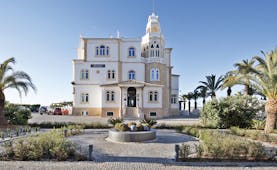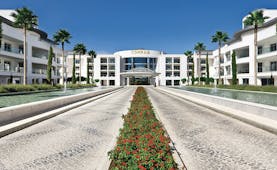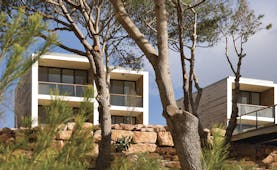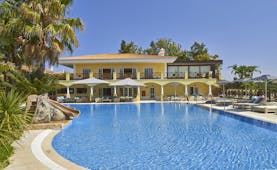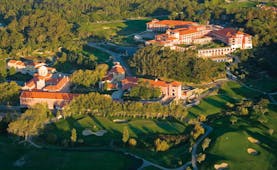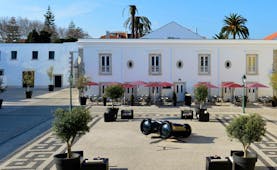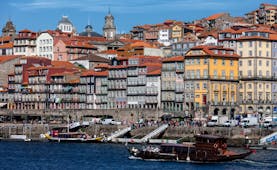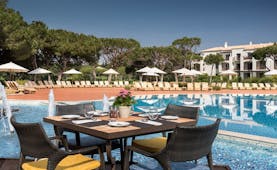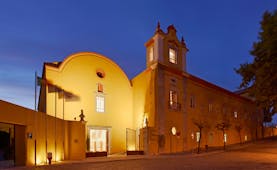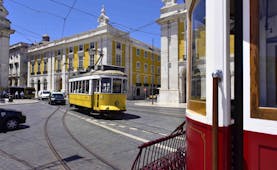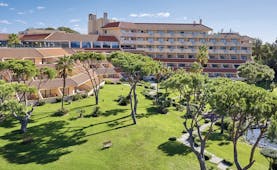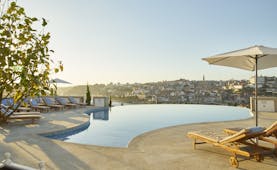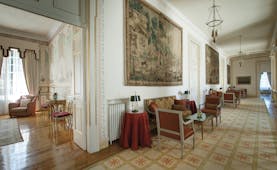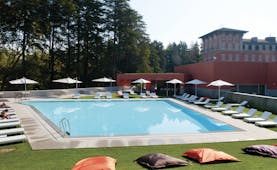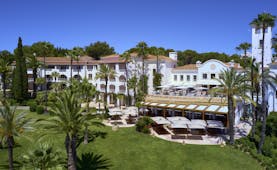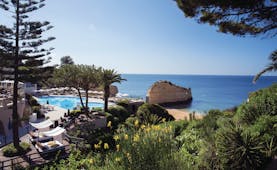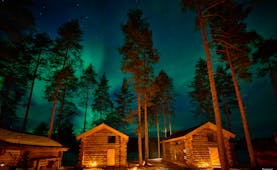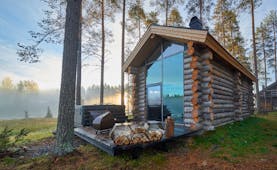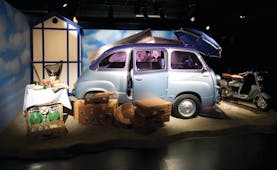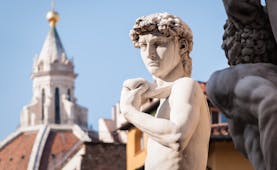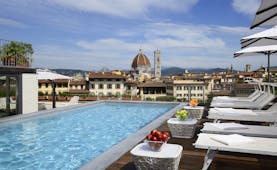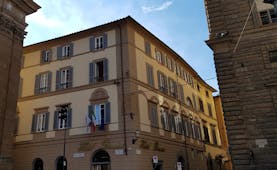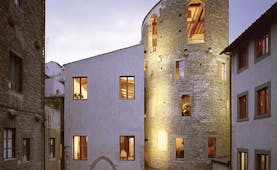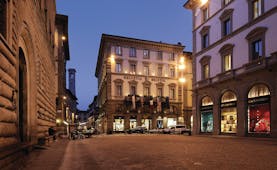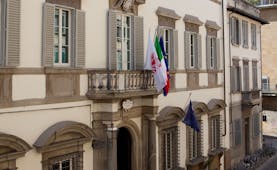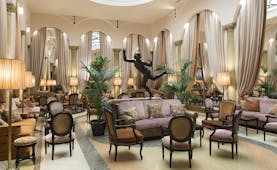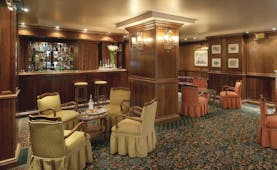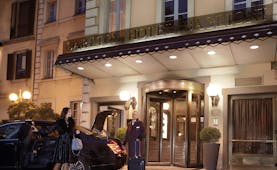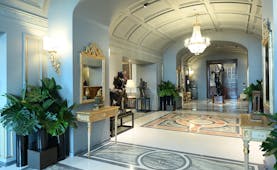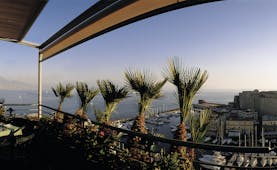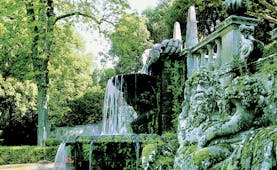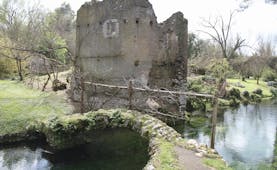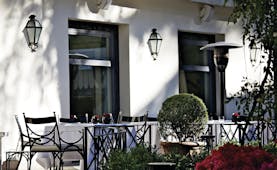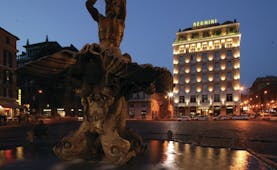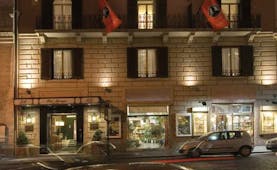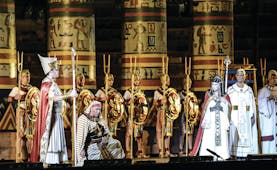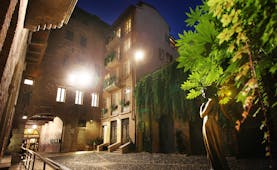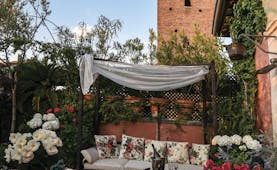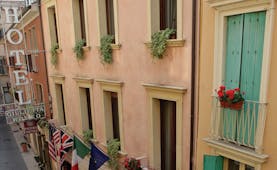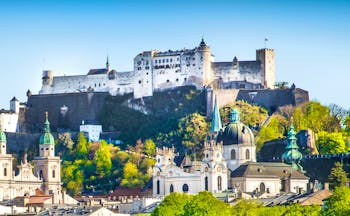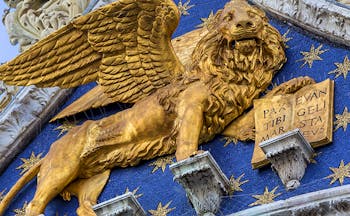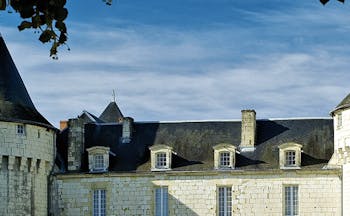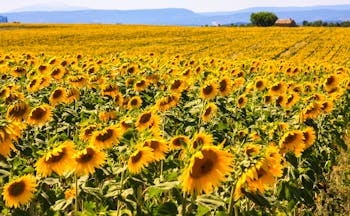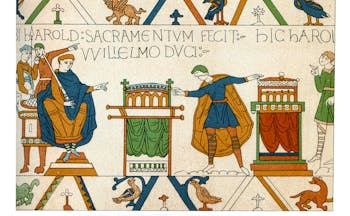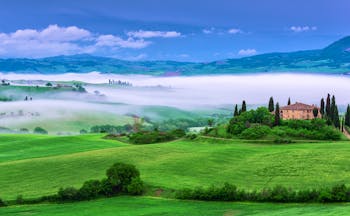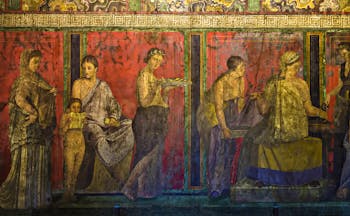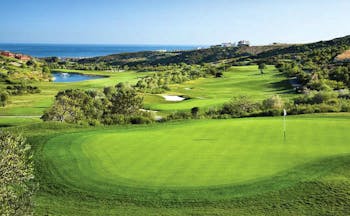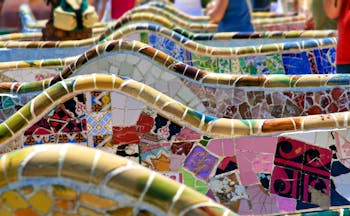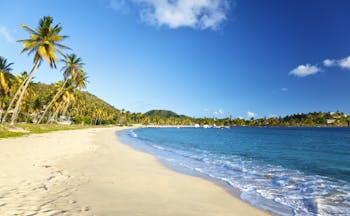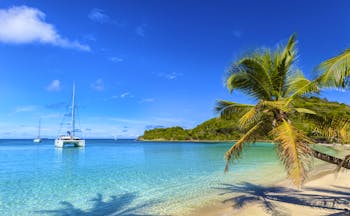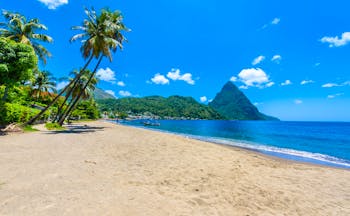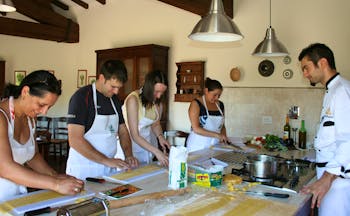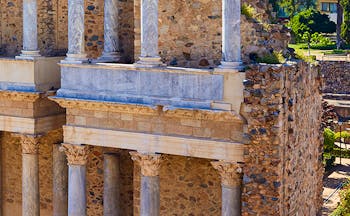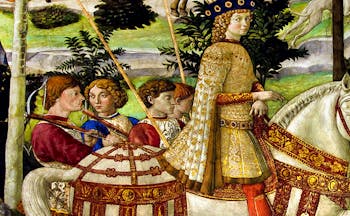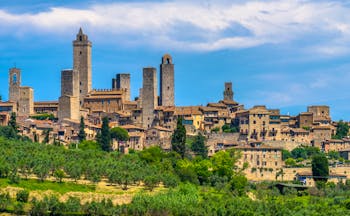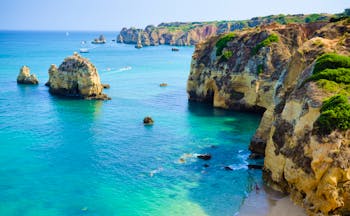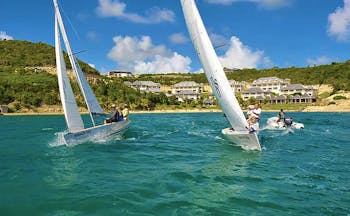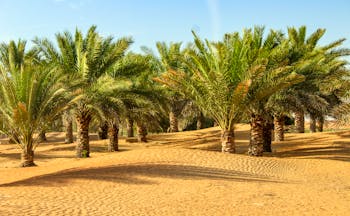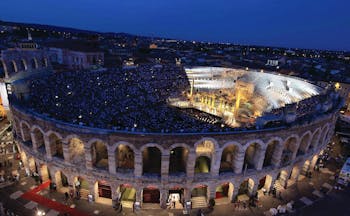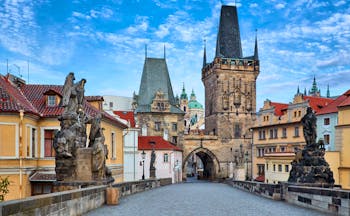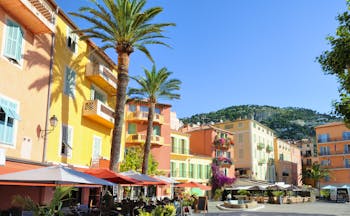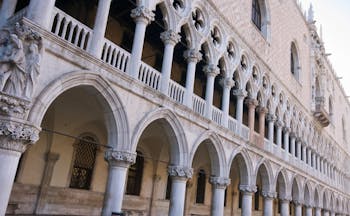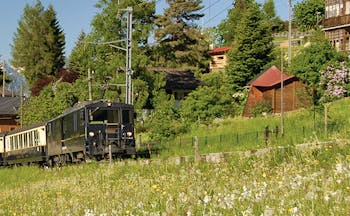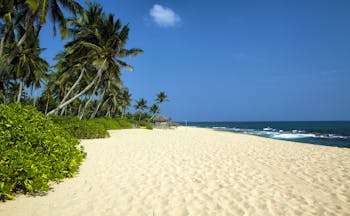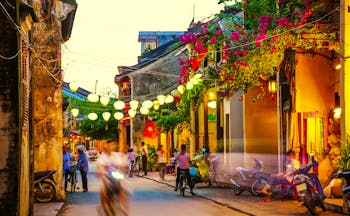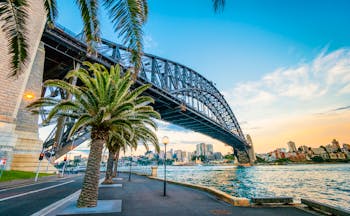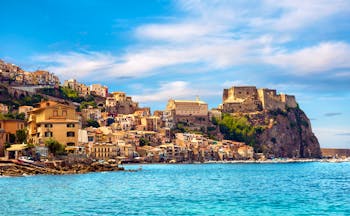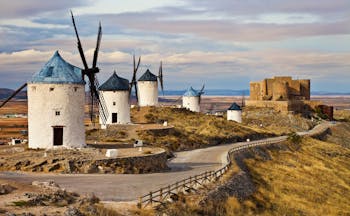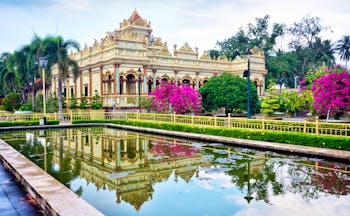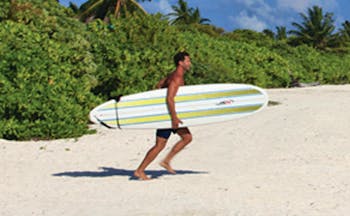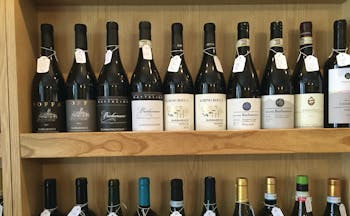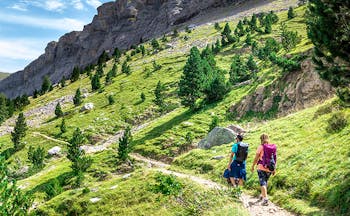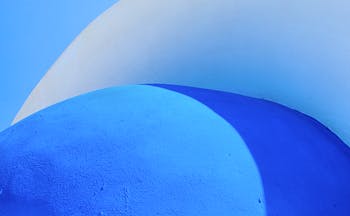Luxury rail touring holiday from Vienna to Venice plus Styrian Alps, Slovenia and Lake Bled
This rail holiday starts with your arrival in Vienna, either by train or by air. Vienna, on the banks of the River Danube and at the heart of central European history since the Roman times. Vienna never fails to impress and satisfy the visitor eager for historical and cultural references. ‘Dream and reality’ still resonate and your days in Vienna can be filled with a mixture of galleries, museums, opera, concerts or eating and drinking in a ‘Heuriger’ in the Vienna Woods. The history of Vienna can be witnessed in the Roman Museum, the Neidhart frescoes dating from the 1400s, the mediaeval Basiliskenhaus, the Imperial Palace and the numerous Jugendstil buildings, and of course in the City of Vienna museum. Upon leaving Vienna, your train speeds south passing spa towns towards the jagged peaks of the Styrian Alps, travelling along the scenic Semmering route, which was the first mountain railway in Europe to be built with a standard gauge track, and the attractive Styrian capital, Graz. The history of Graz is very much bound to that of central Europe, the rule of the Habsburgs and the cultural identity of its both German and Slovene populations. Its charming old town is a harmonious blend of building of different epochs and styles and reflect the borderland that Graz occupies between things Germanic, Italian and Balkan. Into picturesque Slovenia, a small, westerly Slav nation bordered by Austria, Croatia and Italy and known for its beautiful scenery of mountains, forests and lakes. Its capital Ljubljana has an elegant feel with its Baroque houses, painted in shades of pink, rose, yellow and cream lining the Ljubljanica River, crossed by characterful bridges with echoes of Venice. Squares, green spaces, tree-lined streets and outdoor restaurants give Ljubljana an air of gaiety and relaxation. From the capital, it’s a short but scenic train journey to picturesque Lake Bled where you spend two nights before travelling to Venice, la Serenissima. Return home from Venice by air or with an overnight stop in Switzerland.
Highlights
Vienna • Graz • Ljubljana • Lake Bled • Venice
Day by day
Your holiday begins by departing from London after lunch on a Eurostar service to Brussels. Change trains here and continue to Cologne where you will arrive 2 hours later. Once in Cologne, time for something to eat near the Dom, before you continue your journey to Vienna on an overnight sleeper train. (This holiday can be done in 10 nights if you fly to Vienna and return by air from Venice).
You arrive in Vienna in the early morning and will spend two nights here. Drop your bags off at your hotel and begin exploring the city.
Vienna, on the banks of the River Danube, has been at the heart of central European history since the Roman times. Vienna never fails to impress and satisfy the visitor eager for historical and cultural references. ‘Dream and reality’ still resonate and your days in Vienna can be filled with a mixture of galleries, museums, opera, concerts or eating and drinking in a ‘Heuriger’ in the Vienna Woods. The history of Vienna can be witnessed in the Roman Museum, the Neidhart frescoes dating from the 1400s, the mediaeval Basiliskenhaus, the Imperial Palace and the numerous Jugendstil buildings, and of course in the City of Vienna museum. The Hofburg contains numerous national collections from the Crown Jewels to the Imperial armoury. Take time to listen to the Mozart Orchestra playing in the Musikverein, and to enjoy coffee and cake at Demel’s. A fun way to see the sights of the city is to take a tram around the Ringstrasse, hopping off and on as you want.
Depart your hotel mid-morning and board a direct train to Graz. This will take approximately 2 hours 30 minutes and you can enjoy the scenery along the way. Upon leaving Vienna, your train speeds south passing spa towns towards the jagged peaks of the Styrian Alps, along the famous Semmering route, a UNESCO world heritage site and conceived as a feat of ‘landscape gardening’, attempting a harmonious blend of nature and technology, and the attractive Styrian capital, Graz. The history of Graz is very much bound to that of central Europe, the rule of the Habsburgs and the cultural identity of its both German and Slovene populations. Its charming old town is a harmonious blend of building of different epochs and styles and reflect the borderland that Graz occupies between things Germanic, Italian and Balkan. Highlights of the city are the 473m-high Schlossberg that overlooks the city (and reached by a funicular), the 300-year-old clock tower and the 16th century bell tower. Other notable sites to visit are the Town Hall, the Cathedral, the Gemaltes Haus, the Armoury and the Kunsthaus, built in 2003, an example of ‘blob architecture’ and known as the ‘friendly alien’.
Check out of your hotel after breakfast and board a direct service from Graz to Slovenia’s capital, Ljubljana. The landscape is pleasant with its rolling fields and forested hills and particularly scenic between Grobelno and Ljubljana when the route follows the Sava river, a tributary of the Danube. This journey will take approximately 3 and a half hours. Check-in to your hotel in Ljubljana for two nights.
You have a full day to explore Ljubljana. Ljubljana, the Slovenian capital, has as its symbol the Ljubljana dragon, and is visible in the city’s coat of arms, the bridge over the river Ljubljanica and on the top of the castle tower. Castle Hill is a good place to start your tour and it can be reached by funicular or a 20-minute uphill hike. Once at the top, visit Ljubljana Castle and enjoy the views over the city from the castle watchtower. Afterwards, come back down and explore the area around the main square in the city, Preseren Square and the Central Market area. Discover the Old Town or take a stroll along the River Ljubljanica crossing notable bridges such as Dragon Bridge, Butchers’ Bridge, the Triple Bridge, the Fish Footbridge and the Cobbler’s Bridge. Many of the buildings are Baroque in the Italian style There are also lots of museums of interest, which include the City Museum focusing on Ljubljana’s history, culture and politics as well as the National Museum of Slovenia and the Museum of Modern Art. The botanical garden covers almost six acres and is the oldest cultural, scientific and educational organisation in the country.
Today you travel to Lake Bled by train which takes just under one hour to cover the 55 kms. Your hotel is located about a 15-minute taxi journey from the rail station. Spend two nights on Lake Bled.
Lake Bled is a popular Slovenian resort thanks to its emerald-green water, picture-postcard church and mediaeval castle. The tiny Bled island, tear-shaped towards the western side of the lake, adds a fairy-tale quality to the already picturesque surroundings. Lake Bled is fairly small in size measuring 2km by 1380m. Enjoy a walk along the shore taking in the breath-taking scenery as you go, hire a boat or swim in the lake, whose waters are warmed by thermal springs. There are bathing areas on the northern and western shores. Sights to visit include Bled Castle, which is perched 100m above the lake on a steep cliff. The castle dates back to the 11th century and houses a museum collection which details the lake’s history. Travel by gondola to the tiny Bled island which boasts the lovely Church of the Assumption with a gold baroque altar and fragments of 15th Century frescos, and a small museum. Around 4kms from Bled is the Vintgar Gorge with a 1,600m wooden walkway that crosses over rapids and waterfalls before reaching the 13m high Sum Waterfall. Whilst on Lake Bled, be sure to sample the famous vanilla cream pastry, a speciality of the region.
An early morning train will take you from Lake Bled to Venice with an easy change of trains in Villach (Austria). You will arrive in just under 6 hours. On arrival to Venice, we include a private water transfer from the train station to your hotel. You spend three nights in Venice.
Spend two more full days exploring Venice, the “floating city”. Take the time to discover the alleyways, canals and piazzas as well as the lively wine bars and restaurants on offer. Cultural highlights include St Mark’s Square where you can ascend the Campanile by lift for a panorama over Venice and the Lido. Also to be visited is the Doge’s Palace, reflecting powerful and affluent periods of the Venetian democracy as well as the Basilica di San Marco. Take a gondola ride along the Grand Canal and walk across the Bridge of Sighs. Perhaps on your second full day in Venice catch one of the local water taxis to explore the islands of the lagoon. Burano, island of lace-making and fishermen, is impressively picturesque whilst on Murano master craftsmen offer demonstrations of glass-making before you enter their shops. A visit to both these islands is thoroughly recommended to provide an alternative view of Venice. The Accademia, the Museo Correr and the Guggenheim all provide a wealth of art for viewing. The Renaissance and Baroque churches that have somehow been squeezed into all corners of this city are architectural masterpieces and include the Church of the Redentore, the Church of Santa Maria della Salute and San Giorgio Maggiore. Take time to savour Venetian delicacies such as clams, sardines and cuttlefish and enjoy a coffee at Florian’s in St Mark’s Square.
Return from Venice by air today. An alternative is to return by train, with an overnight stop en route, probably in Switzerland, making this option become 13 nights/14 days.
Always happy with travel arrangements and hotel suggestions made and the options put forward by Expressions. Always very responsive and reassuring.Ms M, June 2025
Holiday price guide From £3,440 per person based on two people sharing a double room and including for second class rail travel. First class and Standard premier on Eurostar supplement about £580 per person.
Holiday Code EEBR06
Call us on 01392 441245
Luxury rail touring holiday from Vienna to Venice plus Styrian Alps, Slovenia and Lake Bled
Your holiday begins by departing from London after lunch on a Eurostar service to Brussels. Change trains here and continue to Cologne where you will arrive 2 hours later. Once in Cologne, time for something to eat near the Dom, before you continue your journey to Vienna on an overnight sleeper train. (This holiday can be done in 10 nights if you fly to Vienna and return by air from Venice).
You arrive in Vienna in the early morning and will spend two nights here. Drop your bags off at your hotel and begin exploring the city.
Vienna, on the banks of the River Danube, has been at the heart of central European history since the Roman times. Vienna never fails to impress and satisfy the visitor eager for historical and cultural references. ‘Dream and reality’ still resonate and your days in Vienna can be filled with a mixture of galleries, museums, opera, concerts or eating and drinking in a ‘Heuriger’ in the Vienna Woods. The history of Vienna can be witnessed in the Roman Museum, the Neidhart frescoes dating from the 1400s, the mediaeval Basiliskenhaus, the Imperial Palace and the numerous Jugendstil buildings, and of course in the City of Vienna museum. The Hofburg contains numerous national collections from the Crown Jewels to the Imperial armoury. Take time to listen to the Mozart Orchestra playing in the Musikverein, and to enjoy coffee and cake at Demel’s. A fun way to see the sights of the city is to take a tram around the Ringstrasse, hopping off and on as you want.
Depart your hotel mid-morning and board a direct train to Graz. This will take approximately 2 hours 30 minutes and you can enjoy the scenery along the way. Upon leaving Vienna, your train speeds south passing spa towns towards the jagged peaks of the Styrian Alps, along the famous Semmering route, a UNESCO world heritage site and conceived as a feat of ‘landscape gardening’, attempting a harmonious blend of nature and technology, and the attractive Styrian capital, Graz. The history of Graz is very much bound to that of central Europe, the rule of the Habsburgs and the cultural identity of its both German and Slovene populations. Its charming old town is a harmonious blend of building of different epochs and styles and reflect the borderland that Graz occupies between things Germanic, Italian and Balkan. Highlights of the city are the 473m-high Schlossberg that overlooks the city (and reached by a funicular), the 300-year-old clock tower and the 16th century bell tower. Other notable sites to visit are the Town Hall, the Cathedral, the Gemaltes Haus, the Armoury and the Kunsthaus, built in 2003, an example of ‘blob architecture’ and known as the ‘friendly alien’.
Check out of your hotel after breakfast and board a direct service from Graz to Slovenia’s capital, Ljubljana. The landscape is pleasant with its rolling fields and forested hills and particularly scenic between Grobelno and Ljubljana when the route follows the Sava river, a tributary of the Danube. This journey will take approximately 3 and a half hours. Check-in to your hotel in Ljubljana for two nights.
You have a full day to explore Ljubljana. Ljubljana, the Slovenian capital, has as its symbol the Ljubljana dragon, and is visible in the city’s coat of arms, the bridge over the river Ljubljanica and on the top of the castle tower. Castle Hill is a good place to start your tour and it can be reached by funicular or a 20-minute uphill hike. Once at the top, visit Ljubljana Castle and enjoy the views over the city from the castle watchtower. Afterwards, come back down and explore the area around the main square in the city, Preseren Square and the Central Market area. Discover the Old Town or take a stroll along the River Ljubljanica crossing notable bridges such as Dragon Bridge, Butchers’ Bridge, the Triple Bridge, the Fish Footbridge and the Cobbler’s Bridge. Many of the buildings are Baroque in the Italian style There are also lots of museums of interest, which include the City Museum focusing on Ljubljana’s history, culture and politics as well as the National Museum of Slovenia and the Museum of Modern Art. The botanical garden covers almost six acres and is the oldest cultural, scientific and educational organisation in the country.
Today you travel to Lake Bled by train which takes just under one hour to cover the 55 kms. Your hotel is located about a 15-minute taxi journey from the rail station. Spend two nights on Lake Bled.
Lake Bled is a popular Slovenian resort thanks to its emerald-green water, picture-postcard church and mediaeval castle. The tiny Bled island, tear-shaped towards the western side of the lake, adds a fairy-tale quality to the already picturesque surroundings. Lake Bled is fairly small in size measuring 2km by 1380m. Enjoy a walk along the shore taking in the breath-taking scenery as you go, hire a boat or swim in the lake, whose waters are warmed by thermal springs. There are bathing areas on the northern and western shores. Sights to visit include Bled Castle, which is perched 100m above the lake on a steep cliff. The castle dates back to the 11th century and houses a museum collection which details the lake’s history. Travel by gondola to the tiny Bled island which boasts the lovely Church of the Assumption with a gold baroque altar and fragments of 15th Century frescos, and a small museum. Around 4kms from Bled is the Vintgar Gorge with a 1,600m wooden walkway that crosses over rapids and waterfalls before reaching the 13m high Sum Waterfall. Whilst on Lake Bled, be sure to sample the famous vanilla cream pastry, a speciality of the region.
An early morning train will take you from Lake Bled to Venice with an easy change of trains in Villach (Austria). You will arrive in just under 6 hours. On arrival to Venice, we include a private water transfer from the train station to your hotel. You spend three nights in Venice.
Spend two more full days exploring Venice, the “floating city”. Take the time to discover the alleyways, canals and piazzas as well as the lively wine bars and restaurants on offer. Cultural highlights include St Mark’s Square where you can ascend the Campanile by lift for a panorama over Venice and the Lido. Also to be visited is the Doge’s Palace, reflecting powerful and affluent periods of the Venetian democracy as well as the Basilica di San Marco. Take a gondola ride along the Grand Canal and walk across the Bridge of Sighs. Perhaps on your second full day in Venice catch one of the local water taxis to explore the islands of the lagoon. Burano, island of lace-making and fishermen, is impressively picturesque whilst on Murano master craftsmen offer demonstrations of glass-making before you enter their shops. A visit to both these islands is thoroughly recommended to provide an alternative view of Venice. The Accademia, the Museo Correr and the Guggenheim all provide a wealth of art for viewing. The Renaissance and Baroque churches that have somehow been squeezed into all corners of this city are architectural masterpieces and include the Church of the Redentore, the Church of Santa Maria della Salute and San Giorgio Maggiore. Take time to savour Venetian delicacies such as clams, sardines and cuttlefish and enjoy a coffee at Florian’s in St Mark’s Square.
Return from Venice by air today. An alternative is to return by train, with an overnight stop en route, probably in Switzerland, making this option become 13 nights/14 days.
Always happy with travel arrangements and hotel suggestions made and the options put forward by Expressions. Always very responsive and reassuring.Ms M, June 2025
Holiday price guide From £3,440 per person based on two people sharing a double room and including for second class rail travel. First class and Standard premier on Eurostar supplement about £580 per person.
Holiday Code EEBR06
Our prices include
● Rail travel from London to Vienna and back from Venice in second or standard class (first class and standard premier on Eurostar can be booked as a supplement)
● Return by air from Venice or travel by train with an overnight in Switzerland
● 2 nights’ bed and breakfast in a Classic double room at the Hotel Kaiserhof, Vienna
● 1 night’s bed and breakfast in a Superior double room at the Palais-Hotel Erzherzog Johann, Graz
● 2 nights’ bed and breakfast in a Deluxe double room at the Antiq Palace Hotel and Spa, Ljubljana
● 2 nights’ bed and breakfast in a Double room with lake view at Vila Bled, on Lake Bled
● 3 nights’ bed and breakfast in a Classic double room at the Hotel Bisanzio, Venice
● Transfers in Venice
● Concierge service and Expressions Holidays regional helpful hints
Our prices do not include
● Transfers in any location other than Venice
● Early check-in or late check-out at any hotels (although we can arrange this on request at additional cost)
● Any other services not mentioned above, such as transfers and meals except breakfast at hotels
● Personal holiday insurance. This is essential and cover should be in place from when you book the holiday.
● Local tourist tax, usually between Euros 1 and 3 per person per night, and payable locally to the hotel
● Flights from London to Vienna, Venice to London if you prefer to fly out and back
Call us on 01392 441245
Luxury rail touring holiday from Vienna to Venice plus Styrian Alps, Slovenia and Lake Bled
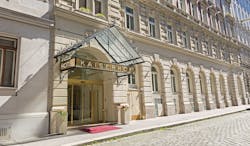
Hotel Kaiserhof Vienna is a four-star hotel in an excellent central location not far from the Karlsplatz. The atmosphere is charming and welcoming, and it is furnished in a traditional way in keeping with the historic building of the hotel.
Classic double room
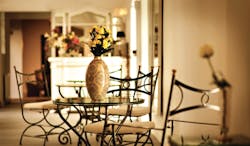
The Antiq Palace Hotel and Spa is a boutique hotel offering historic charm and character in an excellent central location in Ljubljana. This hotel is well placed to explore the city of Ljubljana, and is ideal for a city break or a touring holiday.
Deluxe double room
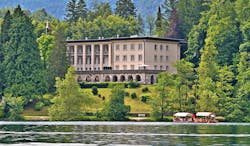
Vila Bled is a 4-star former-presidential villa in a secluded position with spectacular panoramic views of the lake. An award-winning restaurant, private beach and wellness centre alongside comfortable 50s style accommodation afford guests a relaxing and indulgent experience.
Double room with lake view

Hotel Bisanzio is an elegant 4-star hotel, which exudes historical charm, in an excellent position for exploring the main sights of Venice.
Classic double room
Always happy with travel arrangements and hotel suggestions made and the options put forward by Expressions. Always very responsive and reassuring.Ms M, June 2025
Holiday price guide From £3,440 per person based on two people sharing a double room and including for second class rail travel. First class and Standard premier on Eurostar supplement about £580 per person.
Holiday Code EEBR06
Call us on 01392 441245
Luxury rail touring holiday from Vienna to Venice plus Styrian Alps, Slovenia and Lake Bled
About Austria
An Expressions tailor-made holiday to Austria gives travellers the chance to explore and experience this historic and diversely beautiful country. Crowned by the fading imperial glories of Vienna, with central Europe beckoning out along the Danube to the east, and a stunning, chocolate-box Alpine hinterland to the west, Austria is an unbeatable Mitteleuropa beauty. Throughout its eventful history, Austria has retained a penchant for indulgence, opulent aestheticism, and the cultivation of the higher pleasures in life. Visible in the rolling green pastures that cover the lands between the Alps, and in the grand architecture of the cities, this side to Austria still prevails. Inhabited since the Palaeolithic Age, Austria holds a wealth of dramatic and dynamic history within its fertile valleys. Former seat of the Habsburgs, the Austrian capital of Vienna is strewn with architectural riches. Provincial capitals Linz and Graz are now large, cultural towns with vast open squares, beautifully lit fountains, and hilltop castles, but they still retain their cobbled town centres. Salzburg, the birthplace of Mozart, is smattered with stunning baroque churches, and has an Alpine backdrop straight out of the Sound of Music. The wide turquoise River Salzach separates the modern buildings of recently-built Salzburg from the peaked roofs of the older parts of town, which circle the hill on which the stunning Hohensalzburg Castle is perched. Small boats disappear down the river into the lush green valley beyond, where wooden chalet-style houses climb the riverbanks. With ground-breaking cultural figures peppering Austria's history - Freud, Mozart, Strauss, Schubert, and Klimt, to name but a few - the country is awash with important galleries, concert halls, museums, and opera houses. In fact, you won't need to go in search of culture, in Austria it all but waltzes straight up to you. Coupled with spectacular Gothic churches and baroque cathedrals, this makes Austria a fascinating country to explore, with beautiful old coffee houses and cafes almost every step of the way. Beyond the towns, the Tyrol is a hiker's Promised Land, Innsbruck is the radiant, ethereal winter capital, with an array of ski resorts just a step away, and charming old stone village guest-houses. In summer, cowbells tinkle in flower-filled meadows, gluhwein is forever warming over the fire, and whole holidays can be spent just exploring the lakes, forests, summits, and valleys, without setting foot in a bustling, lively town.
Highlights of Austria
The idyllic pathways along the Danube set the scene for romantic afternoon or evening walks, passing either the city or the hilly green countryside dotted with old castles. Seek out the wine estates and cellars of Grinzing, in order to sample some of the best of Austrian produce in a location beyond compare across Europe. The beautiful, cobbled old town of Innsbruck will introduce you to the indescribable atmosphere of the quaint smaller towns of Austria, and act as your gateway into the untamed, rugged landscape of the Alps. The Bregenz Forest forms one of the main regions in Vorarlberg, and is home to the idyllic villages, tinkling cow bells, and alpine dairies that have become both iconic for the region and synonymous with Austria. The Grossglockner Road is a fantastic 30-mile drive that extends through epic glacial mountain scenery, climbing more than 8,000ft to Austria's highest peak, Mount Grossglockner. The phenomena at Krimml Falls include Europe's highest waterfall, which crashes down from mossy green cliffs over jagged brown rocks. For more of Austria's surprising natural beauty, visit the salt mine and ice caves of Hallstatt, a town of simplistic quaint churches and wooden-panelled houses that cling to the banks of the Hallstatter See. Head back into another of Austria's beautiful cities to see the baroque splendours of Salzburg, before climbing the hill of the Hohensalzburg Castle, the city's crowning glory. Krems an der Donau is a charming university town filled with Heuringen, or traditional wine taverns that seem to blend the iconic Italian love of wine with the rustic, homely establishments of the Alpine countries. The hip town of Linz is full of contemporary architecture, including the gravity-defying Voest Steelworks, which points out towards the undulating horizon. Austria's second city, Graz, has a lovely medieval centre with a buzzing cultural scene. Finally, on every stay in Austria, we would recommend soaking up the peace and serenity available at each of our Austrian hotels; the same peace and serenity that continually makes Austria such a fulfilling holiday destination.
Cultural highlights of Austria
Perhaps begin by exploring Vienna's handsome Gothic churches and the baroque cathedral, which look out over the atmospheric, cobbled streets, the most beautiful of which are situated around the University area of Schottentor. Then stop-off for lunch or a light afternoon snack in one of Vienna's coffee houses, or take one of the trams, straight out of the Third Man, which are a wonderfully romantic way to get about town. Admire the vast imperial facade of Schonbrunn Palace, former seat of the Habsburg Empire, and soak up the sunshine beside the Neptune Fountain in the palace gardens, with the charming arches of the Gloriette as your backdrop. For a taste of the city's intellectual culture, visit the Freud museum or the Kunsthistorisches museum, which houses several paintings by Gustav Klimt. Moving and memorable performances can be watched at Vienna's Spanish Riding School and the Boys’ Choir.
Facts in brief
Capital ViennaAirport Vienna is the main transport hub for Austria, but Graz, Linz, Klagenfurt, Salzburg and Innsbruck all receive international flights.
Size 32,000 sq. miles
Population 8 million
Call us on 01392 441245
Luxury rail touring holiday from Vienna to Venice plus Styrian Alps, Slovenia and Lake Bled
About Slovenia
An Expressions tailor-made holiday to Slovenia is a chance to explore and get to know a less popular European holiday destination. Slovenia often passes under the radar for those looking for cultural places to visit, when, in actual fact, it has art galleries to rival the collections of Paris and Venice, and museums that contain artefacts dating back over 60,000 years. Hundreds of ruins and castles can be found across the country, with countless stories to tell from through the ages. The Mediaeval, Renaissance, and Baroque periods left the most prominent marks, though some isolated castles date back to ancient times. Slovenia is a country with a reputation that is being quickly shaped by its environmental priorities. It was the first country in the world to be declared a Green Destination, and its capital, Ljubljana was named the European Green Capital in 2016. The importance placed on environmental issues can be easily traced back to the necessity of preserving the beautiful and diverse landscape that Slovenia has to offer. Sublime lakes, lined with forested mountains, sit within driving distance of historic submediterranean coastlines. Castles and caves provide plenty to explore both above and below ground, and the spa and health resorts dotted around the country offer havens of relaxation that utilise the natural healing properties of the thermal waters. A visit to beautiful, green Slovenia takes you through some of Europe's epic and captivating historical periods, its most naturally beautiful settings, and into a rich hub of virtually undiscovered culture. Slovenia is an up-and-coming destination that suits stays throughout the year.
Highlights of Slovenia
The capital city of Ljubljana gives you the best sense of Slovenia as a whole. Perched above the red roofs of the houses below is the Ljubljana Castle, a mediaeval fortress accessed through the surrounding trees by a steep funicular train. The eponymous river winds its way around the city, separating the stunning old town from the developing commercial, modern half. To cross over from one side of the city to the other, use either the famous Dragon Bridge or the landmark Tromostovje Bridge. Ljubljana is home to the National Museum of Slovenia, which is the perfect place to begin learning about the history of the country, once you have got to grips with the meandering streets and enchanting atmosphere. Though this city is the country's capital, it still remains as green and natural as the country's proud status suggests. Trees overhang the channels of the river, burst out between the pretty buildings, and surround the many squares and bridges.
Cultural highlights of Slovenia
The town of Piran on the Slovenian coast is best known for its salt pans, where the world-famous fleur de sel are still made. The mediaeval town itself, with its colourful stone houses, is a cultural and historic monument and looks out across the stunning Adriatic Sea. The rich green forest of two landscape parks acts as a backdrop. The town's main harbour leads directly onto the irregular shape of the picturesque main square, where arcaded townhouses hide cafes and shops. Visitors here benefit from all the beauty of Alpine Europe as well as the Mediterranean climate. One of the renowned Karst caves, Postojna Cave is the most visited cave in Europe, and has the broadest biological diversity of any cave in the world. The railway that takes you the 5km through its many impressive caverns, corridors, and galleries has been in operation for over 140 years. Guided tours draw your attention to features such as the 16m stalagmite, the oldest underground post office in the world, and the olm 'dragon' fish, which has just begun hatching again in the caves. Predjama Castle is the largest cave castle in the world. It has guarded tunnels that lead to the Postojna Cave for over 800 years, clinging to the side of a sheer rock face, framed by a ring of exposed rock and dense vegetation. In the summer, it hosts the Erazem Knight Tournament. In the north west of the country is Lake Bled. Considered an Alpine lake, Lake Bled is something of a paradise, with Slovenia's only island located on its waters. The picturesque island itself is reason enough to visit: a small curve of trees with a cluster of red-roofed houses and a single tall black spire. You can look down across the lake from the clifftop castle, reached via 90 stone steps, or take a traditional boat, known as a pletna, out onto the water. The thermal springs of Lake Bled paved the way for Slovenia's reputation for health resorts. At the beginning of the 20th century it was particularly revered. Today, the country remains hugely popular with those seeking the expertise of prestigious spa hotels, many of which line Lake Bled's shores. For a true insight into traditional Slovenian culture, visit Lipica, the home of the original stud farm of the Lipizzaner white horses. The farm was first set up in 1580 in the Karst, and today you can still watch the elegant shows or enjoy a horse-drawn carriage ride.
Facts in brief
Capital LjubljanaAirport Ljubljana
Size 20,273 km²
Population 2 million
Call us on 01392 441245
Luxury rail touring holiday from Vienna to Venice plus Styrian Alps, Slovenia and Lake Bled
About Venice
An Expressions tailor-made holiday to Venice is the chance to visit an enchanting and historical city. Venice, or ‘La Serenissima’ as it has been known for centuries, is truly unique and must be visited at least once in a lifetime. It is essentially a floating museum and was the main centre of trade for the north of Italy from the 13th century right through until the 17th century. The Venetian Republic was one of the richest in Europe and was presided over by the Doge who was elected by the Council of Ten, or the most powerful members of the governing families. The art and architecture that can be seen throughout the city is really a tribute to centuries of patronage and wealth. The Venetian lagoon also has numerous other islands, inhabited and uninhabited which used to grow crops and produce to feed Venice itself and which also used to house some of the city's industries such as glass making and lace making.
Cultural highlights of Venice
St Mark’s Square, Doge’s Palace, Bridge of Sighs, The Grand Canal, Accademia, Museo Correr, Rialto Bridge, La Fenice theatre, The Church of the Redentore, The Church of Santa Maria della Salute.
Festivals in Venice
Venice’s most famous festival is the Carnevale in February, the actual dates of Carnevale vary from year to year, but it generally spans three to four weeks ending on Shrove Tuesday. Costumed and masked people parade around the streets of Venice and there are numerous private parties and dances, but the atmosphere on the final night of Carnevale itself is electric. Alternatively, there is the Regata Storica on the first Sunday in September, when boats and gondolas race against each other along the Grand Canal, or the Feast of the Redentore in mid-July to celebrate the end of the plague in the 16th century. A makeshift bridge is constructed to link the Giudecca island with the Dorsodouro island and there is a huge firework display.
Gastronomy in Venice
Venetian food is naturally fish and sea food orientated and popular dishes include the sweet and sour ‘sardee in saor’ or sardine salad, cuttlefish risotto with its black ink and ‘caparossoi a scota deo’, which are large clams cooked with lemon and pepper. Liver is also popular as are several sweet fried delicacies or ‘fritole’, popular particularly around festival time. This area is famous for its Prosecco and is the home of the ‘Bellini’ cocktail.
Travel around Venice
Gondola rides are always popular, but are expensive. The vaporetto and motoscafo services are good and will take you from A to B and are essential to reach the islands of Murano, Burano and Torcello in the lagoon unless you hire a private water taxi. The services can be disrupted at high tide or ‘Aqua Alta’, which usually occurs in the autumn, or if the lagoon is particularly choppy. To cross the Grand Canal the precarious ‘traghetti’ are like large Gondolas, but you are expected to stand up in order for the maximum number of passengers to board, so it is an art, as well as an experience to remember!

